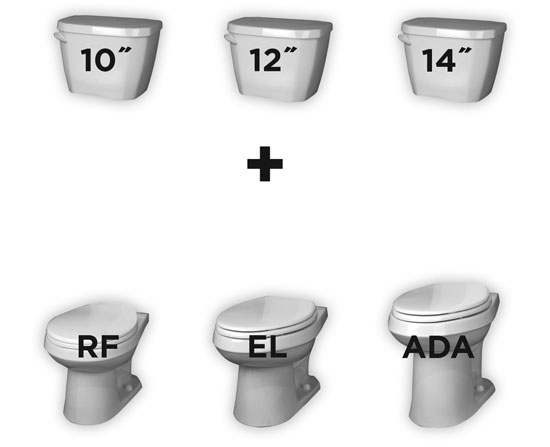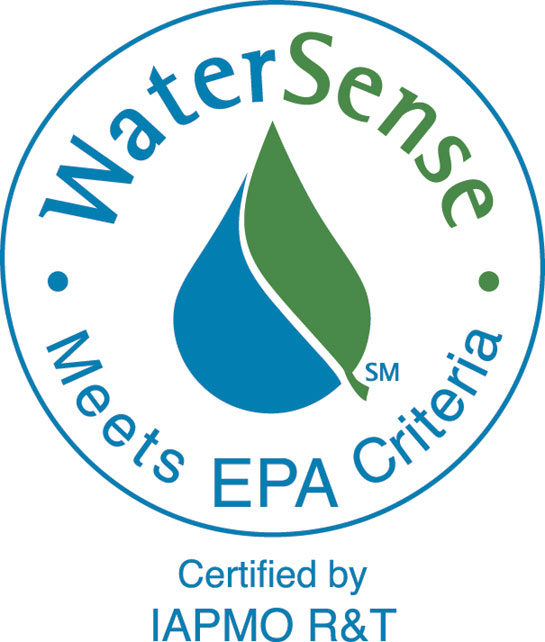Selecting Better Toilets by Design
Tank Sizes
The tank is simply the portion of the toilet that receives and stores water for the next flush. Although the capacity of the tank in terms of gallons of water held for each flush can be held constant for a given design, the physical size and shape can vary. Some of the variation will depend on style. For example, a one-piece toilet with a more contemporary design will commonly include a tank portion that is lower in height and generally appears understated. More typically, the tank is a separate component, also made of vitreous china that connects directly to the inlet in the bowl component. It can be shaped to favor a more round or more square appearance based on its overall design style to match the bowl style.
A significant distinction among tank sizes is the depth from front to back. In most situations it is preferred that the back of the tank sits fairly tight to the wall behind it. However, its location on the bowl is fixed and the location of the bowl is determined by the plumbing rough-in for the sanitary drain line. Usually that rough-in is located such that the center of the sanitary drain line is 12 inches from the wall. Most tanks are designed with a 12 inch rough-in in mind. However, we all know that field conditions do vary and sometimes that rough-in location calls for a shallower or a deeper tank to avoid either a conflict with the wall or a gap behind the tank that is too large. For these situations, manufacturers offer alternative tank depths to accommodate drain line rough-ins ranging from 10 inches to 14 inches that otherwise function the same and essentially have the same appearance as the standard 12-inch rough-in tanks. Hence a plumbing contractor can choose a tank with an appropriate depth and match it with the specified bowl type (round, elongated, ADA compliant, etc.) to achieve a proper installation.

Photo courtesy of Gerber Plumbing Fixtures, LLC
Different depths of tanks can be paired with round front (RF), elongated (EL), or ADA-compliant bowls to suit field installation conditions.
Flush Valve Types
The flush valve is the operational mechanism within the tank that constitutes the “moving parts” of the toilet. All of them rely on a lever or push button operation activated by one hand of the user. That action releases or moves a flapper type of plug such that the full volume of water is allowed to flow down by gravity quickly into the bowl. The flow of water down around the rim causes the swirling action that raises the water level in the bowl and the outlet causing a siphon action that drains everything away. Once the tank is empty, the flapper plug falls back into place closing the connection between the tank and bowl. Concurrently, a float valve of one type or another is used to turn the flow of fresh water on or off. When the tank is full the float is raised up and closes a small valve that would otherwise let water flow into the tank. When the tank is emptied by the lever / flapper plug action, the float drops allowing the valve to open and new water to run into the tank. A smaller amount of fresh water is also channeled down into the bowl to refill it as well. As the tank and bowl re-fill to the designated level, the float rises up again and closes the valve leaving everything ready for the next operation.
The variation between different versions of flush valves often comes down to materials used and minor variations in design. Levers can be placed on the front or side of the tank depending on style while push buttons are often placed on the top. The flapper plug can be shaped in various forms and made from various types and thicknesses of plastic or rubber depending on the durability needed. It can also be connected to the lever by plastic pieces or more durable metal lever arms and beaded chain. The float valve can be a horizontal style or a space saving vertical style that runs up and down along the flush valve mechanism.

Photo courtesy of Gerber Plumbing Fixtures, LLC
A traditional gravity fed, siphon jet toilet shown on the left compared to a compressed air assisted version on the right. The pressure assisted version is well suited to larger apartments, hotels, resorts, etc.
Perhaps the biggest modern advance in flush valves is the use of compressed air to assist in the flushing operation. In this system, a re-designed mechanism traps air in a smaller compartment within the tank. As water fills, it uses the water supply line pressure to compress the trapped air inside. The compressed air is what then forces the tank water into the bowl. Hence, instead of the siphon action of a gravity unit that pulls the water down, the pressure-assist unit pushes water and waste out. This flushing action is obviously more vigorous and manufacturers state that it cleans the bowl better than gravity units. This claim is borne out by the fact that some achieve MaP scores above 1,000 on the order of 1,250 or so certainly by virtue of the addition of the compressed air. The pressure assist is also a particularly good option for larger buildings such as hotels or motels or other situations where the flushing distance is longer to get to the main drain line. Of course, there is a little bit of a price premium and the amount of water needed may vary between models, but they may be the best long-term choice for higher use situations. They are also available with a dual-flush operation meaning that they can be activated to use on the order of 1.1 gallons per flush or 1.6 gallons per flush by varying the amount of air and water that are pushed through.
Green Building Contributions of Flush Toilets
As we have seen, attention to water usage and conservation is a notable concern. While some minimum standards are mandated by regulation, many design professionals are more interested in achieving superior performance as part of an overall green building strategy. In that regard, there are two notable programs that both encourage and recognize water efficiency as part of an environmentally sustainable building.
U.S. EPA WaterSense
Launched in 2006, WaterSense is a voluntary partnership program sponsored by the U.S. Environmental Protection Agency (EPA). It is designed to make it easy for Americans to save water and protect the environment by choosing water-efficient products and services. Items that meet WaterSense specifications must be independently tested and certified, and only then can they carry the WaterSense label. Generally, WaterSense labeled products will be about 20 percent more water efficient than their code minimum counterparts in the same category.
When it comes to toilets, the WaterSense threshold is a maximum 1.28 gallons per flush or less while still providing equal or superior performance. This is 20 percent less water than the current federal standard of 1.6 gallons per flush. In order to earn a WaterSense label, toilets must be independently certified to meet rigorous criteria for both performance and efficiency. Only toilets that complete the third-party certification process can display the WaterSense label.

Image courtesy of U.S. EPA
The WaterSense label is earned for products that are manufactured and tested to use 20 percent less water than comparable “code minimum” products.
The significance of this program is notable. By replacing old, inefficient toilets with WaterSense labeled models, an average family can reduce water used for toilets by 20 to 60 percent—that’s nearly 13,000 gallons of water savings for a typical home every year. Nationally, if all old, inefficient toilets in the United States were replaced with WaterSense labeled models, it could save 520 billion gallons of water per year, or the amount of water that flows over Niagara Falls in about 12 days. From an economic standpoint, the average homeowners could save more than $110 per year in water costs, and $2,200 over the lifetime of the toilets. Further, in many areas, utilities offer rebates and vouchers that can lower the price of a WaterSense labeled toilet.
Whether remodeling a bathroom or designing the construction of a new building, it is worth considering installing WaterSense labeled toilets as a high-performance, water-efficient option. These labeled toilets are available at a wide variety of price points and a broad range of styles by numerous manufacturers. Further, many water utility companies are encouraging their use by offering rebates on the order of $50 – 200 per HET toilet with specific details and requirements for these incentives varying by location. For more information or a list of WaterSense labeled products, visit www.epa.gov/watersense. To learn more about finding rebates for a particular location, see http://www.epa.gov/WaterSense/rebate_finder_saving_money_water.html









